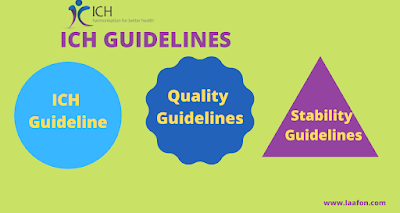ICH Guidelines
What are the ICH Guidelines?
ICH stands for International Conference on Harmonisation, which is a committee that provides a framework for the stability of products in the pharmaceutical industry. ICH guidelines are adopted by every country in the world for the stability conditions and testing of products. ICH guidance is also used for product development and drug substance impurities.
 |
| ich-guideline |
Following is the list of ICH guidelines for stability testing:
ICH Guidance/ Guidelines in detail:
Q1A(R2) - Stability Testing of New Drug Substances and Products: This Guideline provides recommendations on stability testing standards including temperature, humidity, and trial duration for Climatic Zone I and II. And stability testing in Climatic Zones III and IV to minimize the different storage conditions for the requirement of dossier submission.
Q1B - Stability Testing: Photostability Testing of New Drug Substances and Products: This guideline is an annex to the main stability Guideline, that provides guidance on the basic testing protocol required to evaluate the light sensitivity and its effect on the stability of new drugs and products.
Q1C - Stability Testing for New Dosage Forms: This guideline provides the main stability Guideline for new formulations of pre-approved medicines, and also clarifies the circumstances under which reduced stability data can be submitted.
Q1D - Bracketing and Matrixing Designs for Stability Testing of New Drug Substances and Products: This ICH guideline is prepared to meet the recommendations on the application of bracketing and matrixing to stability studies, which are conducted according to principles outlined in the main stability Guideline.
Q1E - Evaluation for Stability Data: This document extends the main stability Guideline by elaborating the possible conditions where extrapolation of retest periods or shelf-lives beyond the real-time data may be appropriate. Rather, it provides some examples of statistical approaches to stability data analysis.
Q1F - Stability Data Package for Registration Applications in Climatic Zones III and IV
In June 2006 Yokohama meeting The ICH Steering Committee endorsed the withdrawal of the Q1F Guideline, and there, the committee decided to leave the definition of storage conditions in Climatic Zones III and IV to the respective regions and WHO.
Q2(R1) - Validation of Analytical Procedures: The guideline is for the validation of analytical procedures and methodology.
Q3A(R2) - Impurities In New Drug Substances: This guideline is for the ICH guidelines for impurities in active pharmaceutical ingredients.
Q3B(R2) - Impurities in New Drug Products: This Guideline on impurities in new drug substances and provides advice in regard to impurities in products containing new, chemically synthesized drug substances.
Q3C(R6) - Impurities: This guideline refers to the protocols for the determination of Residual Solvents in drug Active Pharmaceutical Ingredients and drug products. This guideline also provides the maintenance process for Permitted Daily Exposure.
Q4 - Pharmacopoeia:
Q4A - Pharmacopoeial Harmonization: This guideline is about the mutual discussion between the ICH committee and Different pharmacopoeial authorities Pharmacopoeial Discussion Group (PDG) like USP, JP, and BP.
Q4B - Guideline for Evaluation and Recommendation of Pharmacopoeial Texts for Use in the ICH Regions
Q4B Annex 4A(R1) - Evaluation and Recommendation of Pharmacopoeial Texts for Use in the ICH Regions on Microbiological determination of Non-Sterile Products: Microbial Enumeration Test.
Q4B Annex 4B(R1) - Evaluation and Recommendation of Pharmacopoeial Texts for Use in the ICH Regions on Microbiological Examination of Non-Sterile Products: Test for Specified Microorganisms
Q4B Annex 4C(R1) - Evaluation and Recommendation of Pharmacopoeial Texts for Use in the ICH Regions on Microbiological Examination of Non-Sterile Products: Acceptance Criteria for Pharmaceutical Preparations and Substances for Pharmaceutical Use
Q4B Annex 1(R1) - This document is the result of the Q4B process for the Residue on Ignition/Sulphated Ash General Chapter.
Q4B Annex 2(R1) - Evaluation and Recommendation of Pharmacopoeial Texts for Use in the ICH Regions on Test for Extractable Volume of Parenteral (Injectables) Preparations
Q4B Annex 3(R1) - Evaluation and Recommendation of Pharmacopoeial Texts for Use in the ICH Regions on Test for Particulate Contamination: Sub-Visible Particles
Q4B Annex 5(R1) - Evaluation and Recommendation of Pharmacopoeial Texts for Use in the ICH Regions on Disintegration Test (DT test)
Q4B Annex 6(R1) - Evaluation and Recommendation of Pharmacopoeial Texts for Use in the ICH Regions on Uniformity of Dosage Units (Uniformity of content)
Q4B Annex 7(R2) -This guideline is for the Evaluation and Recommendation of Pharmacopoeial Texts for Use in the ICH Regions on the Dissolution Test
Q4B Annex 8(R1) - Evaluation and Recommendation of Pharmacopoeial Texts for Use in the ICH Regions on Sterility Test (For Injectable and eye drops)
Q4B Annex 9(R1) - Evaluation and Recommendation of Pharmacopoeial Texts for Use in the ICH Regions on Tablet Friability test.
Q4B Annex 10(R1) - Evaluation and Recommendation of Pharmacopoeial Texts for Use in the ICH Regions on Polyacrylamide Gel Electrophoresis
Q4B Annex 11 - Evaluation and Recommendation of Pharmacopoeial Texts for Use in the ICH Regions on Capillary Electrophoresis
Q4B Annex 12 - Evaluation and Recommendation of Pharmacopoeial Texts for Use in the ICH Regions on Analytical Sieving
Q4B Annex 13 - Evaluation and Recommendation of Pharmacopoeial Texts for Use in the ICH Regions on Bulk Density and Tapped Density of Powders
Q4B Annex 14 - Evaluation and Recommendation of Pharmacopoeial Texts for Use in the ICH Regions on Bacterial Endotoxins Test
Q4B - Evaluation and Recommendation of Pharmacopoeial Texts for Use in the ICH Regions
Q5A(R1) - Viral Safety Evaluation of Biotechnology Products Derived from Cell Lines of Human or Animal Origin
This guideline is concerned with testing and evaluation of the viral safety of biotechnology products that are derived from specified cell lines of human or animal origin and outlines the data that should be submitted in the marketing application/registration package.
The motive of this Guideline is to provide a general framework for various virus testing, experiments for the assessment of viral clearance, and a recommended approach for the design of viral tests and viral clearance studies.
Q5B - Quality of Biotechnological Products: Analysis of the Expression Construct in Cells used for Production of r-DNA Derived Protein Products
This guideline is used to describe the types of information that are considered valuable in assessing the structure of the expression construct used to produce recombinant DNA-derived proteins.
Q5C - Quality of Biotechnological Products: Guidelines for stability testing of Biotechnological/ Biological Products
This guideline enlights the stability Guideline (Q1A) and summarizes the particular aspects of stability test procedures needed to take account of the special characteristics of such products in which the active components are typically proteins and/or polypeptides.
Q5D - Derivation and Characterisation of Cell Substrates Used for Production of Biotechnological/ Biological Products
This guideline refers to broad guidance on appropriate standards for the derivation of human and animal cell lines and microbial cells used to prepare biotechnological/biological products, and for the preparation and characterization of cell banks to be used for production.
Q5E - Comparability of Biotechnological/ Biological Products Subject to Changes in their Manufacturing Process
The main motive of this guideline is to give the principles for checking the comparability of biotechnological/biological products before and after changes are made in the manufacturing process for the API drug substance or drug product.
Q6A - Specifications: Test Procedures and Acceptance Criteria for New Drug Substances and New Drug Products: Chemical Substances
This guideline is for providing the guidelines for the acceptance criteria and the selection of test procedures for new drug substances of synthetic chemical origin, and new drug products produced from those synthetic chemicals, which products have not been registered previously in the ICH regions.
Q6B - Specifications: Test Procedures and Acceptance Criteria for Biotechnological/ Biological Products
This guideline is used for providing some common principles on the setting and justification of a uniform set of international specifications for proteins and polypeptides which are produced from recombinant or nonrecombinant cell-culture expression systems.
Q7 - ICH Q7 guidelines have Good Manufacturing Practice Guide for APIs (Active Pharmaceutical Ingredients) during the manufacturing process
This guideline is made to provide guidance regarding Good Manufacturing Practice (GMP) for the manufacturing of Active Pharmaceutical Ingredients (APIs) under an optimum system for the management of quality. It is also intended to help ensure that APIs meet the requirements for quality and purity that they purport or are represented to possess.
Q8(R2) - Pharmaceutical Development
This Guideline is used to provide guidance on the contents of Section 3.2.P.2 (Pharmaceutical Development) for drug products as defined in the scope of Module 3 of the Common Technical Document (ICH topic M4).
Q9 - Quality Risk Management: Recommendations for evaluation of risk involved in manufacturing processes.
This Guideline is used to provide us the principles and examples of tools for quality risk management that can be applied to different aspects of pharmaceutical products' quality.
Q10 - Pharmaceutical Quality System: Recommendations to maintain the quality of the product.
This Guideline is used for the systems used in supporting the development and manufacture of pharmaceutical drug substances (API) and drug products. This guideline includes biotechnology and biological products. Also, provide guidelines for the complete self-life of products.
Q11 - Development and Manufacture of Drug Substances (Chemical Entities and Biotechnological/ Biological Entities)
This Guideline clarifies the aspects important for developing and understanding the manufacturing process of the drug substance (APIs). This guideline also provides the aspects related to impurities in drug substances.
Q12 - Lifecycle Management: Guidelines on lifecycle management of pharmaceutical products.
This Guideline is designed to provide a protocol to facilitate the management of post-approval Chemistry, Manufacturing, and Controls (CMC) changes in a more predictable and efficient manner across the product lifecycle.
Q13 - Continuous Manufacturing of Drug Substances and Drug Products: Provide guidance to industry and regulatory agencies regarding regulatory expectations on the development, implementation, and assessment of CM technologies used in the manufacture of drug substances and drug products.
Q14 - Analytical Procedure Development
This guideline captures the key technical and regulatory considerations and also helps drug manufacturers to employ flexible approaches to develop, implement, or integrate CM for the manufacturing of drug substances(APIs) and drug products(Formulations).
This guideline also provides guidance to industry and regulatory agencies related to regulatory expectations on the development, implementation, and assessment of the manufacturing processes.
Related Posts :
- DPCO List 2016
- DPCO price of Vildagliptin+Metformin Tablet
- LATEST DPCO LIST OF 40 ITEMS
- DPCO LIST OF 14 FORMULATIONS 2020
- Budesonide Inhaler DPCO Price
- DPCO price of TD Vaccine and Tacrolimus Tablet
- DPCO List of October 2020
- SOP for Environment monitoring
- DPCO price of Praziquantel Tablet
- DPCO price of TD Vaccine and Tacrolimus Tablet
- SOP for Preparation of Sanitizing solution




Please not enter any spam link in the comment box.